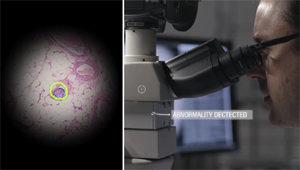



Date:18/04/18
 Google engineers introduced a prototype microscope "with augmented reality," which uses artificial intelligence to detect cancer cells in tissue samples.
Google engineers introduced a prototype microscope "with augmented reality," which uses artificial intelligence to detect cancer cells in tissue samples.
Developers of the search giant had enough to modify a conventional optical microscope. The area that is viewed in the eyepiece is fixed by the camera and sent to the neuronet to be eaten. They define pathological cells and use a transparent display to designate this area. On the augmented image, these places are immediately visible, which greatly facilitates the task of a specialist. According to the authors of the project, this approach is not inferior to traditional diagnostics by a professional pathologist in accuracy.
While experiments were conducted on systems trained to recognize prostate and breast cancer. Already now they operate in real time with a frequency of 10 frames per second. When you move the sample, the image is immediately scanned and the result is instantly displayed.
Because not all laboratories can afford to purchase a digital microscope for early detection of cancer cells. It's much cheaper to integrate the camera and display into an "analog" model using the available components. How much such an upgrade can do is not reported.
In Google they want to train their microscope to recognize other types of cancer, tuberculosis and malaria. There are no global plans for the introduction of new technology for the team yet - first you need to test everything.
Smart Google microscope helps diagnose cancer
 Google engineers introduced a prototype microscope "with augmented reality," which uses artificial intelligence to detect cancer cells in tissue samples.
Google engineers introduced a prototype microscope "with augmented reality," which uses artificial intelligence to detect cancer cells in tissue samples.Developers of the search giant had enough to modify a conventional optical microscope. The area that is viewed in the eyepiece is fixed by the camera and sent to the neuronet to be eaten. They define pathological cells and use a transparent display to designate this area. On the augmented image, these places are immediately visible, which greatly facilitates the task of a specialist. According to the authors of the project, this approach is not inferior to traditional diagnostics by a professional pathologist in accuracy.
While experiments were conducted on systems trained to recognize prostate and breast cancer. Already now they operate in real time with a frequency of 10 frames per second. When you move the sample, the image is immediately scanned and the result is instantly displayed.
Because not all laboratories can afford to purchase a digital microscope for early detection of cancer cells. It's much cheaper to integrate the camera and display into an "analog" model using the available components. How much such an upgrade can do is not reported.
In Google they want to train their microscope to recognize other types of cancer, tuberculosis and malaria. There are no global plans for the introduction of new technology for the team yet - first you need to test everything.
Views: 449
©ictnews.az. All rights reserved.Similar news
- Azerbaijani project to monitor disease via mobile phones
- Innovative educational system to be improved under presidential decree
- NTRC prolongs license of two TV and radio organizations for 6 years
- Azerbaijan establishes e-registry for medicines
- Azerbaijani museum introduces e-guide
- Nar Mobile opens “Nar Dunyasi” sales and service center in Siyazan city
- International conference on custom electronic services held in Baku
- OIC secretary general to attend COMSTECH meeting in Baku
- Azerbaijan develops earthquake warning system
- New law to regulate transition to digital broadcasting in Azerbaijan
- Azerbaijani State Social Protection Fund introduces electronic digital signature
- Intellectual traffic management system in Baku to be commissioned in December
- Tax Ministry of Azerbaijan started receiving video-addresses
- World Bank recommends Azerbaijan to speed up e-service introduction in real estate
- Azerbaijan to shift to electronic registration of real estate





















